The Flat Rack Containers Market is estimated to be valued at USD 4.8 billion in 2025 and is projected to reach USD 8.9 billion by 2035, registering a compound annual growth rate (CAGR) of 6.4% over the forecast period.
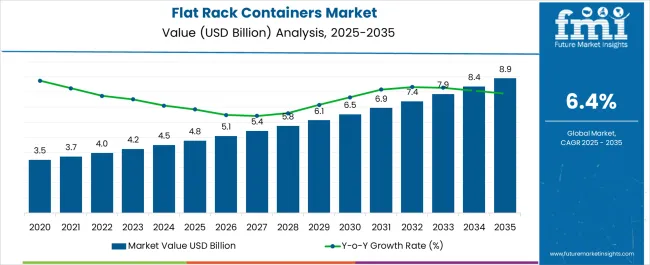
| Metric | Value |
|---|---|
| Flat Rack Containers Market Estimated Value in (2025 E) | USD 4.8 billion |
| Flat Rack Containers Market Forecast Value in (2035 F) | USD 8.9 billion |
| Forecast CAGR (2025 to 2035) | 6.4% |
The Flat Rack Containers market is experiencing strong growth, driven by increasing demand for versatile and high-capacity shipping solutions across global logistics, trade, and transportation sectors. The expansion of international trade and e-commerce has created a need for containers that can accommodate oversized, irregularly shaped, and heavy cargo efficiently. Advancements in container design, such as collapsible structures and modular support systems, are enhancing flexibility, reducing storage costs, and improving operational efficiency.
Rising investment in port infrastructure, intermodal transportation, and fleet modernization is supporting market adoption. Regulatory standards for container safety, durability, and environmental compliance are further shaping the landscape. Flat rack containers provide adaptability for multi-modal transport, allowing seamless transfer between ships, rail, and trucks.
The growing emphasis on supply chain optimization, load security, and cargo protection is driving increased adoption across shipping companies, freight forwarders, and logistics operators As global trade volumes continue to rise, the market is expected to witness sustained growth, with innovations in container design, material strength, and operational efficiency serving as key drivers of market expansion.
The flat rack containers market is segmented by container type, support, size, end use industry, and geographic regions. By container type, flat rack containers market is divided into Collapsible Containers and Non-Collapsible Containers. In terms of support, flat rack containers market is classified into With Walls and Without Walls. Based on size, flat rack containers market is segmented into 40 Feet Containers and 20 Feet Containers. By end use industry, flat rack containers market is segmented into Machinery Industry, Heavy Goods Industry, and Others. Regionally, the flat rack containers industry is classified into North America, Latin America, Western Europe, Eastern Europe, Balkan & Baltic Countries, Russia & Belarus, Central Asia, East Asia, South Asia & Pacific, and the Middle East & Africa.
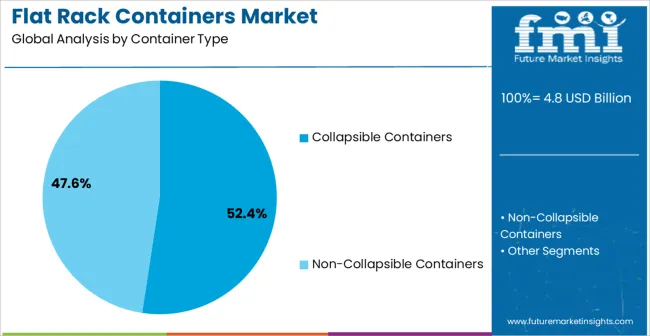
The collapsible containers segment is projected to hold 52.4% of the Flat Rack Containers market revenue in 2025, positioning it as the leading container type. This dominance is driven by the ability of collapsible containers to optimize storage space when not in use, reducing transportation and warehousing costs. Their modular design allows for easy assembly and disassembly, enhancing operational flexibility for shippers and logistics providers.
Collapsible containers are particularly preferred for transporting oversized and irregularly shaped goods, as their adaptable structure can accommodate varying cargo dimensions. The durability and strength of modern materials ensure safe handling and long service life, which further strengthens adoption.
Increasing focus on supply chain efficiency, intermodal transport compatibility, and cargo protection has reinforced the market position of collapsible containers As companies seek cost-effective and versatile container solutions to manage growing freight volumes, collapsible containers are expected to maintain their leading position, supported by continuous design innovation and improved operational convenience.
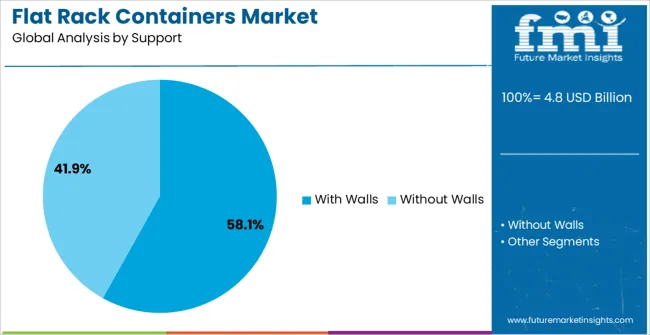
The with walls support segment is expected to account for 58.1% of the market revenue in 2025, making it the leading support type. Its growth is being driven by the enhanced cargo security and stability provided by container walls during transit, which reduces the risk of damage to oversized and heavy goods. With walls support enables easier stacking, lifting, and handling in ports, rail yards, and intermodal transportation settings.
This support type also improves operational safety and compliance with global shipping standards. Rising demand for multi-purpose containers that can handle various cargo types efficiently has reinforced adoption. Logistics operators benefit from increased load retention and protection, especially for fragile or high-value goods.
Integration with intermodal transport systems and compatibility with standard handling equipment further enhance the segment’s appeal As international trade continues to expand and supply chains become increasingly complex, the with walls support segment is expected to remain the preferred choice for ensuring cargo safety, operational efficiency, and adaptability in containerized transportation
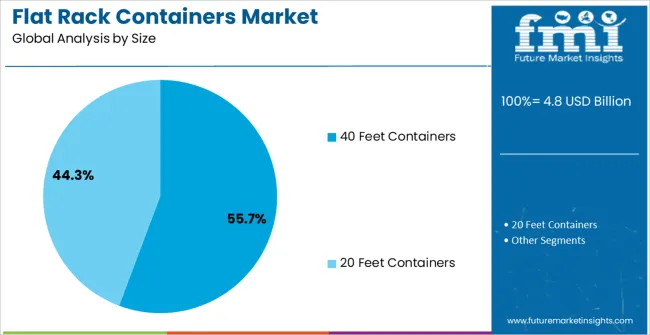
The 40 feet containers size segment is projected to hold 55.7% of the market revenue in 2025, establishing it as the leading container size. This dominance is being driven by the global preference for standardized dimensions that optimize shipping capacity, reduce handling complexity, and enable efficient stacking in ships, railcars, and trucks. The 40 feet containers provide an ideal balance between volume capacity and maneuverability, making them suitable for a wide range of cargo types, including oversized and heavy goods.
Standardization enhances intermodal transport compatibility, reduces operational delays, and lowers logistics costs. Increasing demand from international shipping companies, freight forwarders, and industrial manufacturers has reinforced adoption.
Modern 40 feet flat rack containers are designed to withstand high loading stresses while ensuring safety and cargo integrity As global trade volumes grow and supply chain optimization becomes a priority, the 40 feet containers size segment is expected to retain its market leadership, supported by widespread industry acceptance, operational efficiency, and adaptability to diverse shipping requirements.
Flat rack containers are used for transportation of heavy goods. These flat rack containers are especially designed for the carriage of heavy and large products such as boats, machinery, lumber and other such heavy products. These containers are suitable for heavy loads and cargo which needs loading from side or top.
These containers can be transported through roadways, railways and waterways. These are specialized containers which are collapsible as well as non-collapsible containers. They either come with or without walls. Generally, steel is used in the formation of flat rack containers. These flat rack containers are used for goods which require easy loading and unloading. They are available in sizes such as 20 feet and 40 feet.
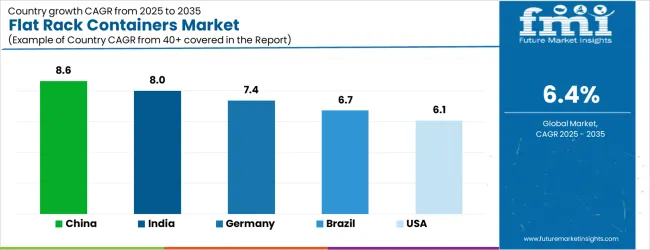
| Country | CAGR |
|---|---|
| China | 8.6% |
| India | 8.0% |
| Germany | 7.4% |
| Brazil | 6.7% |
| USA | 6.1% |
| UK | 5.4% |
| Japan | 4.8% |
The Flat Rack Containers Market is expected to register a CAGR of 6.4% during the forecast period, exhibiting varied country level momentum. China leads with the highest CAGR of 8.6%, followed by India at 8.0%. Developed markets such as Germany, France, and the UK continue to expand steadily, while the USA is likely to grow at consistent rates. Japan posts the lowest CAGR at 4.8%, yet still underscores a broadly positive trajectory for the global Flat Rack Containers Market. In 2024, Germany held a dominant revenue in the Western Europe market and is expected to grow with a CAGR of 7.4%. The USA Flat Rack Containers Market is estimated to be valued at USD 1.7 billion in 2025 and is anticipated to reach a valuation of USD 1.7 billion by 2035. Sales are projected to rise at a CAGR of 0.0% over the forecast period between 2025 and 2035. While Japan and South Korea markets are estimated to be valued at USD 260.9 million and USD 128.7 million respectively in 2025.
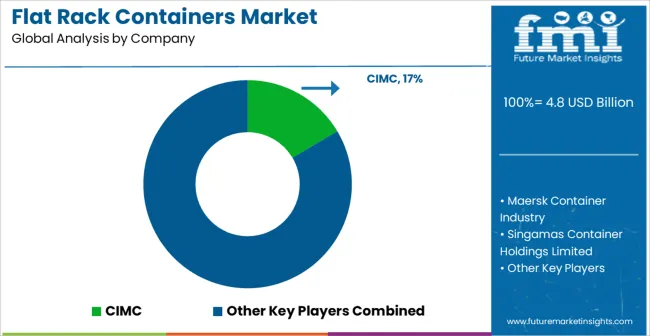
| Item | Value |
|---|---|
| Quantitative Units | USD 4.8 Billion |
| Container Type | Collapsible Containers and Non-Collapsible Containers |
| Support | With Walls and Without Walls |
| Size | 40 Feet Containers and 20 Feet Containers |
| End Use Industry | Machinery Industry, Heavy Goods Industry, and Others |
| Regions Covered | North America, Europe, Asia-Pacific, Latin America, Middle East & Africa |
| Country Covered | United States, Canada, Germany, France, United Kingdom, China, Japan, India, Brazil, South Africa |
| Key Companies Profiled | CIMC, Maersk Container Industry, Singamas Container Holdings Limited, China Shipping Container Lines Co., Ltd., Hyundai Translead, W&K Container Inc., Seaco Global Ltd., Triton International Limited, Textainer Group Holdings Limited, Florens Asset Management Company Ltd., Beacon Intermodal Leasing, LLC, and CAI International, Inc. |
The global flat rack containers market is estimated to be valued at USD 4.8 billion in 2025.
The market size for the flat rack containers market is projected to reach USD 8.9 billion by 2035.
The flat rack containers market is expected to grow at a 6.4% CAGR between 2025 and 2035.
The key product types in flat rack containers market are collapsible containers and non-collapsible containers.
In terms of support, with walls segment to command 58.1% share in the flat rack containers market in 2025.






Our Research Products

The "Full Research Suite" delivers actionable market intel, deep dives on markets or technologies, so clients act faster, cut risk, and unlock growth.

The Leaderboard benchmarks and ranks top vendors, classifying them as Established Leaders, Leading Challengers, or Disruptors & Challengers.

Locates where complements amplify value and substitutes erode it, forecasting net impact by horizon

We deliver granular, decision-grade intel: market sizing, 5-year forecasts, pricing, adoption, usage, revenue, and operational KPIs—plus competitor tracking, regulation, and value chains—across 60 countries broadly.

Spot the shifts before they hit your P&L. We track inflection points, adoption curves, pricing moves, and ecosystem plays to show where demand is heading, why it is changing, and what to do next across high-growth markets and disruptive tech

Real-time reads of user behavior. We track shifting priorities, perceptions of today’s and next-gen services, and provider experience, then pace how fast tech moves from trial to adoption, blending buyer, consumer, and channel inputs with social signals (#WhySwitch, #UX).

Partner with our analyst team to build a custom report designed around your business priorities. From analysing market trends to assessing competitors or crafting bespoke datasets, we tailor insights to your needs.
Supplier Intelligence
Discovery & Profiling
Capacity & Footprint
Performance & Risk
Compliance & Governance
Commercial Readiness
Who Supplies Whom
Scorecards & Shortlists
Playbooks & Docs
Category Intelligence
Definition & Scope
Demand & Use Cases
Cost Drivers
Market Structure
Supply Chain Map
Trade & Policy
Operating Norms
Deliverables
Buyer Intelligence
Account Basics
Spend & Scope
Procurement Model
Vendor Requirements
Terms & Policies
Entry Strategy
Pain Points & Triggers
Outputs
Pricing Analysis
Benchmarks
Trends
Should-Cost
Indexation
Landed Cost
Commercial Terms
Deliverables
Brand Analysis
Positioning & Value Prop
Share & Presence
Customer Evidence
Go-to-Market
Digital & Reputation
Compliance & Trust
KPIs & Gaps
Outputs
Full Research Suite comprises of:
Market outlook & trends analysis
Interviews & case studies
Strategic recommendations
Vendor profiles & capabilities analysis
5-year forecasts
8 regions and 60+ country-level data splits
Market segment data splits
12 months of continuous data updates
DELIVERED AS:
PDF EXCEL ONLINE
Flat Nylon Webbing Market Size and Share Forecast Outlook 2025 to 2035
Flat Suction Cup Market Size and Share Forecast Outlook 2025 to 2035
Flat Vacuum Suction Cup Market Size and Share Forecast Outlook 2025 to 2035
Flat Bag Back-blowing Dust Collector Market Size and Share Forecast Outlook 2025 to 2035
Flatback Tape Market Size and Share Forecast Outlook 2025 to 2035
Flatting Agents Market Size and Share Forecast Outlook 2025 to 2035
Flatbed Die Cutters Market Size and Share Forecast Outlook 2025 to 2035
Flat Panel Antenna Market Size and Share Forecast Outlook 2025 to 2035
Flatbed Trucks Market Size and Share Forecast Outlook 2025 to 2035
Flat Valve Caps And Closures Market Size and Share Forecast Outlook 2025 to 2035
Flat Bottom Pouch Market Size and Share Forecast Outlook 2025 to 2035
Flat Bottom Bags Market Size and Share Forecast Outlook 2025 to 2035
Flat Glass Market Growth & Demand 2025 to 2035
Flat Panel Display Market Analysis by Technology, Application, and Region through 2025 to 2035
Flatware Market Analysis - Growth & Demand Forecast 2025 to 2035
Flat Panel X-Ray Detectors Market Analysis by Application, Product, and Region Forecast Through 2035
Analyzing Flatback Tape Market Share & Industry Leaders
Leading Providers & Market Share in Flat Bottom Pouch Manufacturing
Market Share Insights of Leading Flat Glass Coating Providers
Flat Steel Market Growth – Trends & Forecast 2024-2034

Thank you!
You will receive an email from our Business Development Manager. Please be sure to check your SPAM/JUNK folder too.
Chat With
MaRIA